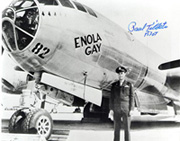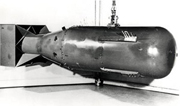Enola Gay
IntroductionIn 1980, Orchestral Manoeuvres in
the Dark (OMD) made the song Enola Gay.
Enola Gay was the name of the aircraft which dropped
the first atomic bomb. During the flight the Enola Gay
was accompanied by The Great Artiste, an
aircraft with and recording wquipment and by The
Necessary Evil, a plane carrying photographers.
Another B-29 Superfortress bomber, and reconnaissance
aircraft flew half an hour ahead to check whether the
weather was suitable.
Watch and listen to the song:
Enola Gay (live).
|
Lyrics |

Hiroshima
August 6, 1945 - It's a cool morning. The work in the factories and offices in the Japanese port of Hiroshima has just begun. Then flashed a blinding white light. The fishermen at sea and the farmers behind the mountain range that surrounds the city on three sides, hear a terrifying rumble. Above the city rises on a huge white cloud. Shortly thereafter ash and rocks obscure the Sun.
Victims
In the first atomic attack on Hiroshima on August 6, 1945 78,000 people were directly killed. By the after-effects from the radiation the death toll rose ultimately to about 140,000 at the end of 1945.

Copyright: Albert van der Kaap, 2011
